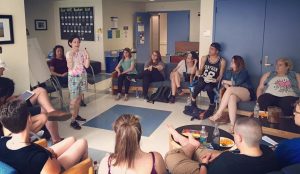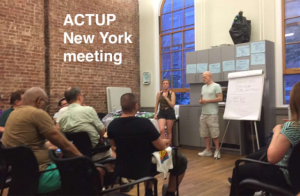The third day of our study abroad saw a break in the streak of perfect weather, the heat and humidity leading us to come up with creative ways to fan ourselves and multiple trips to local cafés for more iced coffee. Nonetheless we delved deep into learning about the very issues for which many of us came on this trip to learn about. We met with extremely bright scholars and passionate activists who educated us on a variety of issues, ranging from the development of attitudes towards queer people throughout history to learning how to become activists ourselves.
We first met with Nina, a French historian. Nina was able to give us a broad overview of the last thousand years of queer history and what general Western attitudes have been towards sex, gender, and sexuality over time. Though I had heard many of these things before, her narrative of the historical events as a timeline helped me to gain a better grasp on how present day views have been shaped. Focusing specifically on sexuality, she said that in ancient societies such as Greece and Rome, same sex relationships were completely normal, only they were called pederasty. It was not until the Catholic Reformation beginning in the 16th century that it was made out to be a near unforgivable sin, punishable by death. Laws started to be made criminalizing same sex acts. Nonetheless, queer people started to form a culture despite all of the oppression that they faced, and developing a collective identity. In the 19th century, there was more research that went into understanding people with same sex desires. However, the term “homosexual” was first coined in 1868 as medical terminology to describe a mental illness; an illness which people began trying to “cure.” Though we have made great strides since then, we still see people today who believe in curing homosexuality through conversion therapy. Nina wrapped up this history by saying it is only in the last 100 years that homosexuality has come to be viewed as a lifestyle. Though this has been a good way for gay and lesbian people to begin to develop a life suited around their identities, I believe referring to homosexuality as a lifestyle rather than an identity has also fed to the idea that it is a choice, which is certainly not the case.
specifically on sexuality, she said that in ancient societies such as Greece and Rome, same sex relationships were completely normal, only they were called pederasty. It was not until the Catholic Reformation beginning in the 16th century that it was made out to be a near unforgivable sin, punishable by death. Laws started to be made criminalizing same sex acts. Nonetheless, queer people started to form a culture despite all of the oppression that they faced, and developing a collective identity. In the 19th century, there was more research that went into understanding people with same sex desires. However, the term “homosexual” was first coined in 1868 as medical terminology to describe a mental illness; an illness which people began trying to “cure.” Though we have made great strides since then, we still see people today who believe in curing homosexuality through conversion therapy. Nina wrapped up this history by saying it is only in the last 100 years that homosexuality has come to be viewed as a lifestyle. Though this has been a good way for gay and lesbian people to begin to develop a life suited around their identities, I believe referring to homosexuality as a lifestyle rather than an identity has also fed to the idea that it is a choice, which is certainly not the case.
We also met with Annette, a long time AIDS activist and ACT UP member. Annette walked us through her process of how she goes from a basic idea to a full fledged “direct action.” It all starts with a vision: an all encompassing mission that should shine through in every action you plan to do to promote your cause. You also need to have goals: measurable and concrete things you’re trying to achieve.
through her process of how she goes from a basic idea to a full fledged “direct action.” It all starts with a vision: an all encompassing mission that should shine through in every action you plan to do to promote your cause. You also need to have goals: measurable and concrete things you’re trying to achieve.
One important thing Annette said is that being an activist does not necessarily mean performing civil disobedience acts and getting arrested. Activism can be calling your state legislator and writing letters. It can be starting a hashtag on Twitter to promote a cause through your social network. But as Annette said, a single act on social media, while still important, should never be a substitute to direct actions such as calling your legislator. From the perspective of my generation, I think both of these types of activism are still very important for reaching out to both the younger audience which is constantly engaging in social media, and the older generations which still rely heavily on physical actions to really get their attention.
Everything came together when we met with ACT UP NY, which can
be identified as the single HIV/AIDS activism organization which helped to end the AIDS epidemic of the 1980’s-90’s by relentless advocation for the development of a lifesaving drug for people living with HIV. Because of their actions, one such lifesaving drug was finally re leased in 1996, which saved the lives of approximately 6 million already infected people that would have otherwise been doomed by the virus. We were able to meet individuals who were long time survivors of HIV and activists who had been fighting for the cause for many years, some of them since the movement first came together in the late 1980’s. It was extraordinary to be in the presence
leased in 1996, which saved the lives of approximately 6 million already infected people that would have otherwise been doomed by the virus. We were able to meet individuals who were long time survivors of HIV and activists who had been fighting for the cause for many years, some of them since the movement first came together in the late 1980’s. It was extraordinary to be in the presence of such heroic people whose activism has saved so many lives over the years. What was perhaps most incredible though, was that the ACT UP members were just normal people. It reminded me that anyone really can make a difference.
of such heroic people whose activism has saved so many lives over the years. What was perhaps most incredible though, was that the ACT UP members were just normal people. It reminded me that anyone really can make a difference.
